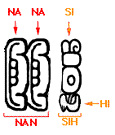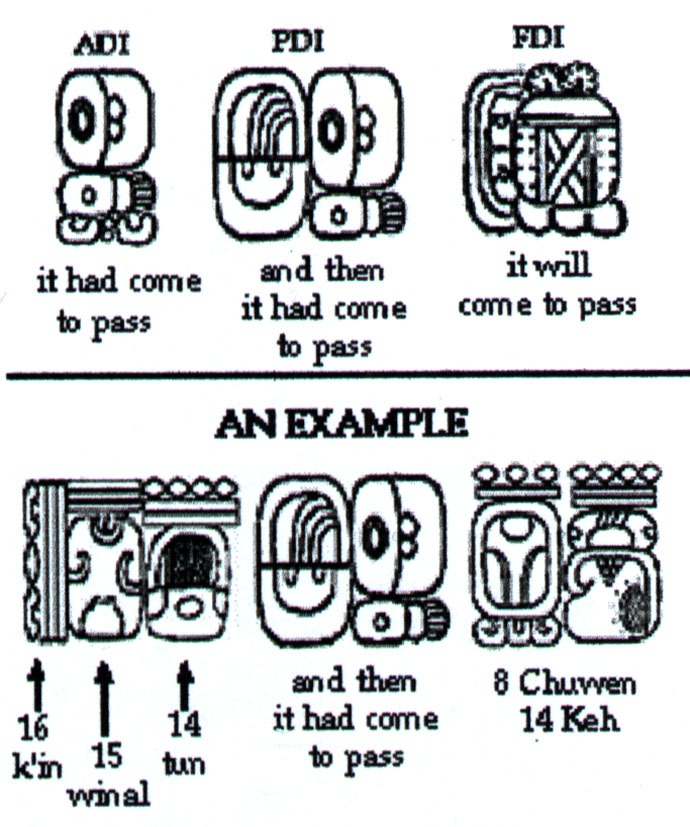Writing with syllables
Mayan hieroglyphic writing is made up of symbols that represent whole words (logographs) or syllables consisting of consonant-vowel pairs (CV) or vowels (V). You can find the symbols representing the syllables at the Write your name in Maya hieroglyphs page.
In syllabic writing, words are spelled out by signs ordered within glyph blocks. In most (but not all) cases, words ending in consonants (CVC) are formed according to the principle of synharmony, first noted by Yuri Knorosov, where the vowel of the last syllable matches the vowel of the syllable immediatly preceding it.
An example

OK, but how does this actually work? Well suppose I wanted to write the name of Nancy. The first symbol I would use is the Moon Goddess head, which is simply an indicator that what follows describes a woman (no prefix was necessary for men's names). After that her name itself begins. The closest I can get phonetically to Nancy is "nan sih". To get "nan", I start out with a sign for "na", and then using the principle of synharmony, follow with a syllable ending in "a", in this case another "na" to give "nan(a)". In the same was, "si" if followed by "hi" to give "sih(i)".
I might have used an alternative method: instead of using two "na" syllables in a row, I could have put two small dots in front of a single "na". Such constructions were occasionally used by the Maya to indicate that a syllable should be read twice.
Because the principle of synharmony does not always hold true, and words with differing vowels in the last two syllables may actually end at the last consonant, indicators that the final vowel is to be voiced, usually "ya" or "yi", are sometimes included (as noted by David Stuart). Look at the next glyph. It reads: mi ki ne li ya which reduces to mik(i)neli(ya) or mikneli.
Infixing
Combinations of syllables are sometimes written in contracted form by infixing one symbol or some of its characteristics into another. In the examples below, "la" has been combined with "ha" and "chi" with "yi" to yield "lah" and "yich". This sort of conflation is sometimes done with logographs as well; the third example is a combination of "nik" and "sak" to produce "white flower", a common methaphor for the soul.
Phonetic Complements
Syllables can also be used as phonetic complements; when a sign has more than one meaning, inclusion of an extra syllable can make clear what reading is intended. For instance, one version of the syllable "ku" can also mean "tun" (stone), "haab" (year), or, when contained within a cartouche, can be the day-sign "kawak". When "tun" is the intended meaning, the syllable "ni" is sometimes added to show that the sign is meant to be read with a terminal n.
Special cases
Ah an Na
As I mentioned above, women's names were always preceded by the Moon Goddess head form of the syllable "na". This is usually translated as "Lady" or "she". The male equivalent of this was "ah". But if men's names didn't need any introductory phrase, what was "ah" used for?
Both "ah" and "na" are found in titles. A Maya ruler might have a list of such titles after his name, some with "ah" (for example, "ah k'al bak" - "he who has twenty captives") and some without (e.g. "bakab" - "the upright one"). Here again men and woman differed; a woman's titles were always preceded by "na" (a woman would be "na bakab", never just "bakab").
The use of titles wasn't limited to rulers: subordinate members of the aristocracy might have "sahal" or "na sahal" after their names. Members of some profession aused descriptive titles as well. A Maya scribe might put "ah tz'ib" - "he of the writing" after his name (I don't know of any ezample of "na tz'ib" ever being used - sigh).
U and Y
The many forms of the vowel U can be represent his, hers, or its when preceding a noun, and he, she, or it when preceding a verb. If the word in question begins with a vowel, Y substitutes for U. A commonly encountered example of this is in parentage statements, often written in the following was: (1st) the name and titles of the person being described (2nd) "y-al" ("her child", sometimes given as "child of the mother") followed by the mother's name and titles (3rd) "u nichin" (literally, "his flower(child)" or "child of the father") followed by the father's name and titles. Use of these prefixes can shade the meaning of a word: "ahaw" means lord, while the possesses form, "y-ahaw" ("his lord"), indicates a lower-ranking lord who "belongs" to some more powerfull figure.
Ti and Ta
Ti and ta served as all-purpose prepositions in mayan languages: to, as, for, from, on, at, etc. Context was the one clue to how either of these syllables was intended.
Distance numbers

Keeping track of correct dates was very important to the Maya (after all, according to the Popol Vuh, human kind was created by the gods for the purpose of praising their names and keeping their days). Mayan texts began with a base date (see Maya Calendars for more information). In the narrative that followed, the reader was provided with a precise date for each event by means of distance numbers (DN).
Distance numbers come in three types: those that refer to an event that occured before the base date, anterior date indicators (ADI), after the base date, posterior date indicators (PDI), and those that referred to events yet to come, future date indicators (FDI).
How were they used? In the example phrase, a period of 16 days, 15 uinal (15 x 20 days), and 14 tun (14 x 360 days) has passed since the previously given date. This information, along with the current day and month positions (calendar round) define the time that the event about to be described occured.
This might be easier to understand given an equivalent statement using our calendar. I might say, "On August 1, 1996 (the base date), I bought a house. 3 days, 2 weeks, and 1 month (the DN) passed until it was (the PDI) September 17, 1996 (the calendar round) when I moved into it (the event).
When a number of events were described in succession, each DN gave the number of days in regards to the last date given; only the first DN would refer to the base date.
Period Endings
The completion of a period of time (tun, katun, etc.) was often an occasion for ceremony and ritual. These events were recorded as (1) the calendar round on which the ending ocurred, (2) the verb "it was completed:, (3) the number and time period which had ended - in the example given, u hun katun, the first katun of the baktun.
A Little Grammar
Word Order
In English, sentences are written with the basic order subject, verb, object. In Mayan languages, the standard order is verb, object, subject. The statement, "The dog found a skunk" would be expressed in Mayan as "Found skunk dog". With intransitive verbs, where there is no object, the order is verb then subject: "Dog stinks" would be "Stinks dog". (A reallife example of something that happened while Nancy McNelly typed this text). The same is true of passive verbs: "The dog was washed" would be "Was washed the dog".
Verbal Affixes and a General Verb
There is one verb that turns up in many contexts and is used in phrases that describe the action taking place. This is "u bah", which can be roughly translated as "s/he goes/is doing", usuallt followed by the syllable "ti", the general preposition and the second verb. In the first example, "u bah ti ak'ot ti hasaw-chan" means "he goed to dancing with a ceremonial banner", the second "ti" being used as a standard preposition, "with", Some verbs can be written either with "u bah" or simply with a U or Y for he/she/it, as in the second example.
Symbols were often added to verbs as indicators of tense or type. Transitive verbs were prefixed with U or Y (see rules above) and subfixed with "wa" or "wi". The "moon" version of "ha": was postfixed to passive verbs, where it was pronounced "ah". "Hiy" was subfixed to intransitive verbs. Mayan dialects have a fourth type of verb, positionals; "The dog sits" is an example of this class. "Wan" or "lah" were used as affixes for these verbs.
Affixes can alter the meaning of a verb. In the example above, putting U before the verb tz'ap (to set up) makes it active, while postfixing "ha" makes it passive. The verb chak, meaning decapitate or destroy, is passive with "ha", s/he is beheaded or it is destroyed. The second form uses a special postfix, "bahi" (sometimes "tu bah") which means for him or herself - in this case "he decapitates himself".
Puting It All Together
Glyph Blocks
Within glyph blocks, syllable signs and logographs are generally ordered to be read from top to bottom and left to right. Text composed with these glyph blocks is most often arranged to be read in the same direction, but with the glyphs read in pairs as in the diagram given below.
Step 4
Choose the combination of syllable symbols you like best and construct a glyph block according to the rules given in the Note on the writing system. If you're female, remember that the first character in your name is always the profile of a wonma's head (OK, this might not be PC, but then neither were the classic Maya).
Symbols can overlap as long as they're in the correct order (they should read top to bottom and left to right).
Let's try it!
OK, let's try a name, say, Nancy. This is pronounced Nansih, and from the vowel chart above, we know that it would start with NA followed by a second NA. The second part of the name starts with and SI, and the principle of synharmony tells us that it should end with the same vowel as the syllable before it. So what comes last must be HI.
Next we look up these syllables in the syllabary to find out what our choices are.
And finally, we try putting the syllables together in the proper order until we find the combination we like best. Here is Nancy's name as she wrote it in hieroglyphs:
Wyszukiwarka
Podobne podstrony:
writing syllabus second sem 2010-2011, Year 1, Writing WSz, II sem. Handouts+ Syllabus
writing syllabus first sem 2010-2011, Year 1, Writing WSz, I sem. Handouts + Syllabus
Writing Quality Content Expressing With the Right Words 2010
Walterowicz, Łukasz A comparative analysis of the effects of teaching writing in a foreign language
islcollective worksheets beginner prea1 elementary a1 elementary school writing plur lurals with mis
Writing Programs with NCURSES
A Way With Words I Writing Rhetoric And the Art of Persuasion Michael D C Drout
Image Processing with Matlab 33
Types of syllabuses
L 5590 Short Sleeved Dress With Zipper Closure
M 5190 Long dress with a contrast finishing work
2006 SOM 208 Microbiology Syllabus Septic Shock
O'Reilly How To Build A FreeBSD STABLE Firewall With IPFILTER From The O'Reilly Anthology
First 2015 Writing sample paper Nieznany
M 5450 Dress with straps
Dance, Shield Modelling of sound ®elds in enclosed spaces with absorbent room surfaces
popkultura baranska syllabus z Katedry Dalekiego Wschodu
kurs excel (ebook) statistical analysis with excel X645FGGBVGDMICSVWEIYZHTBW6XRORTATG3KHTA
Chinese character writing Exercise sheets 2
więcej podobnych podstron